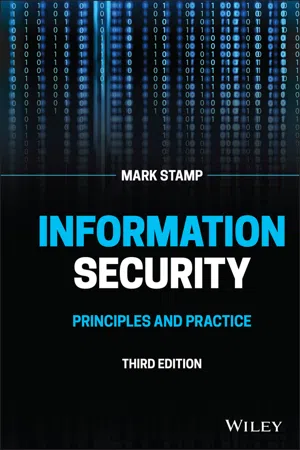
- English
- ePUB (mobile friendly)
- Available on iOS & Android
About this book
Provides systematic guidance on meeting the information security challenges of the 21st century, featuring newly revised material throughout
Information Security: Principles and Practice is the must-have book for students, instructors, and early-stage professionals alike. Author Mark Stamp provides clear, accessible, and accurate information on the four critical components of information security: cryptography, access control, security protocols, and software. Readers are provided with a wealth of real-world examples that clarify complex topics, highlight important security issues, and demonstrate effective methods and strategies for protecting the confidentiality and integrity of data.
Fully revised and updated, the third edition of Information Security features a brand-new chapter on network security basics and expanded coverage of cross-site scripting (XSS) attacks, Stuxnet and other malware, the SSH protocol, secure software development, and security protocols. Fresh examples illustrate the Rivest-Shamir-Adleman (RSA) cryptosystem, Elliptic-curve cryptography (ECC), and hash functions based on bitcoin and blockchains. Updated problem sets, figures, tables, and graphs help readers develop a working knowledge of classic cryptosystems, symmetric and public key cryptography, cryptanalysis, simple authentication protocols, intrusion and malware detection systems, and more. Presenting a highly practical approach to information security, this popular textbook:
- Provides up-to-date coverage of the rapidly evolving field of information security
- Explains session keys, perfect forward secrecy, timestamps, SSH, SSL, IPSec, Kerberos, WEP, GSM, and other authentication protocols
- Addresses access control techniques including authentication and authorization, ACLs and capabilities, and multilevel security and compartments
- Discusses software tools used for malware detection, digital rights management, and operating systems security
- Includes an instructor's solution manual, PowerPoint slides, lecture videos, and additional teaching resources
Information Security: Principles and Practice, Third Edition is the perfect textbook for advanced undergraduate and graduate students in all Computer Science programs, and remains essential reading for professionals working in industrial or government security.
To request supplementary materials, please contact [email protected] and visit the author-maintained website for more: https://www.cs.sjsu.edu/~stamp/infosec/.
Frequently asked questions
- Essential is ideal for learners and professionals who enjoy exploring a wide range of subjects. Access the Essential Library with 800,000+ trusted titles and best-sellers across business, personal growth, and the humanities. Includes unlimited reading time and Standard Read Aloud voice.
- Complete: Perfect for advanced learners and researchers needing full, unrestricted access. Unlock 1.4M+ books across hundreds of subjects, including academic and specialized titles. The Complete Plan also includes advanced features like Premium Read Aloud and Research Assistant.
Please note we cannot support devices running on iOS 13 and Android 7 or earlier. Learn more about using the app.
Information
Chapter 1
Introductions
1.1 The Cast of Characters

1.2 Alice's Online Bank
1.2.1 Confidentiality, Integrity, and Availability
1.2.2 Beyond CIA
www.alicesonlinebank.com , how does he know that the transaction he sees on his screen is the same transaction that actually goes to the bank? That is, how can Bob be confident that his software (not to mention the network) is behaving as it should, instead of as Trudy would like it to behave? We'll consider these sorts of questions as well.1.3 About This Book
- Specification/policy — What is the system supposed to do?
- Implementation/mechanism — How does it do it?
- Correctness/assurance — Does it really work?
- Human nature — Can the system survive “clever” users?
Table of contents
- Cover
- Title Page
- Copyright Page
- Dedication Page
- Preface
- About the Author
- Acknowledgments
- Chapter 1 Introductions
- Part I Crypto
- Part II Access Control
- Part III Topics in Network Security
- Part IV Software
- Appendix
- Bibliography
- Index
- End User License Agreement